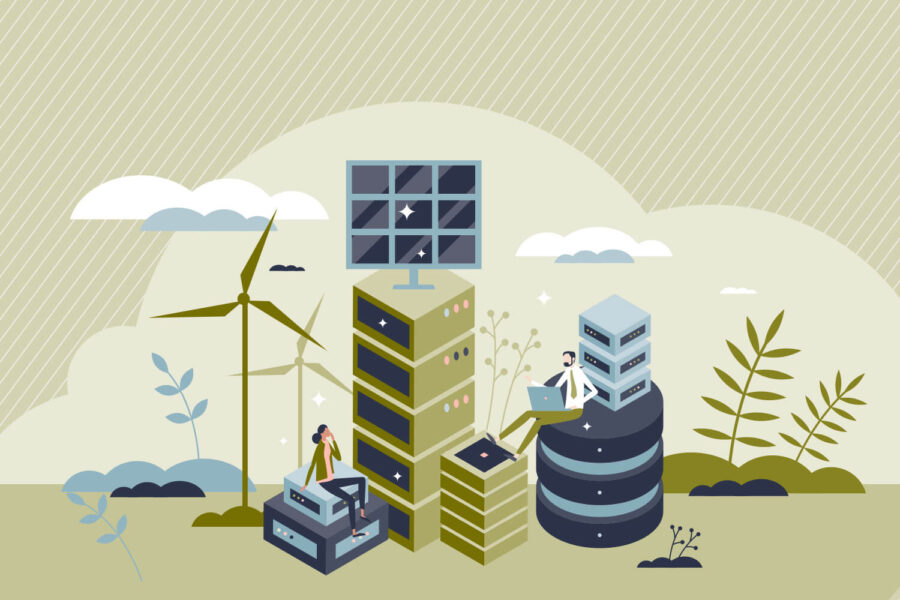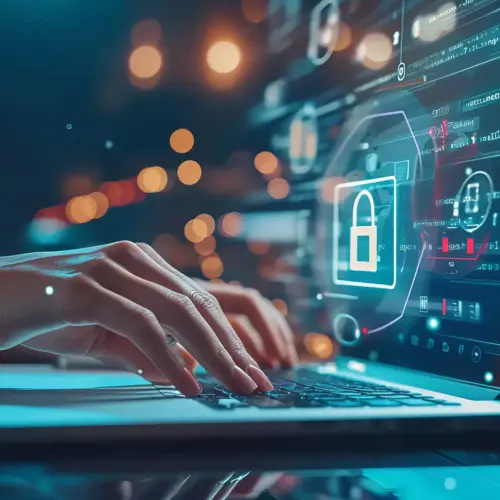Data centers are facilities that house and centralize technology, power, and cooling equipment to enable IT operations. Increasingly, these sites are used for cloud computing. Cloud data centers processed 94% of all workloads in 2021, and that number will only increase with the continued rollout of 5G and growth of big-data analytics, generative artificial intelligence, machine learning models, and other trends.
However, data centers have also come under increased scrutiny for their energy use. In a recent blog, we shared data centers’ current and projected electricity consumption and provided an array of strategies for improving energy sustainability. In this one, we’ll describe how data centers are using different clean energy sources, such as solar, wind, geothermal, hydroelectric, and biomass, to achieve sustainability goals. We’ll also present solutions that cloud service providers and enterprises face to scaling renewable energy usage.
Read our blog, Increasing Data Center Energy Sustainability: Short- and Long-Term Strategies
Why Use More Renewable Energy?
So, why are data centers using more renewable energy? Over the short-term, data centers want to reduce costs. Energy costs are surging, and companies want to reduce spending to protect their profitability.
Over the long-term, leaders want to future-proof their business models and operations in an era of growing resource scarcity. Data centers use vast amounts of electricity to power servers and other equipment. Electricity constraints, high sustained prices, demand charges, and regulatory fines for legacy processes can make operations commercially unviable.
In addition, many leaders want their companies to work proactively towards transforming energy usage, to be a good corporate citizen, minimize environmental harm, and lead on sustainability issues.
Green energy is vital to current and future data center operations because it is abundant, continuously generated, and emits little to no greenhouse gasses or pollutants. Fossil fuels, on the other hand, are fast depleting, due to their pervasive use and non-renewability. As a result, they’re slated to begin running out this century. In addition, fossil fuels are the largest contributor to global climate change, causing 75 percent of global greenhouse gas emissions (GHGs) and almost 90 percent of carbon dioxide emissions.
Source: Our World in Data
The International Renewable Energy Association (IRENA) projects that governments, businesses, and individuals can achieve the 2050 goal of limiting global temperature gains to 1.5°C by implementing six different technology pathways. Increasing use of eco-friendly energy sources and improving energy efficiency account for half of all gains.
Source: IRENA
Using Clean Energy to Become More Sustainable and Reduce Costs
Using more renewable power enables data center owners and operators to accomplish multiple sustainability goals, including:
- Reducing their carbon footprint and GHG emissions: Green energy has a lower environmental impact than fossil fuels across siting, deployment, and logistics and can be deployed faster. They also reduce GHG emissions. A study found that renewable energy sources emit on average 50g or less of CO2 emissions per kWh over their lifetime, compared to about 1000 g CO2/kWh for coal and 475 g CO2/kWh for natural gas.
- Lowering energy consumption and costs: In our previous blog, we cited research that forecasts data center electricity consumption will grow from 1% to 8% in 2030. Globally, 61.3% of electricity is currently generated from fossil fuels, while just 28% is generated by renewable energy technology. As a result, there is work to be done to increase the use of renewables.
The good news is that renewable energy prices have fallen, due to technology advances such as scale solar production practices and battery energy capture. Nearly two-thirds (62%) of the renewables that came on stream in 2020 were cheaper than the least expensive fossil fuel. New onshore wind projects cost about $46 per megawatt-hour and large-scale solar plants cost $45 per megawatt-hour, while new coal-fired plants cost $74 per MWh and gas plants are $81 per MWh.
Falling prices for new projects are a favorable development for data center operators. By incorporating more renewables into their energy mix, they can reduce energy costs, both now and in the future. - Improving energy efficiency and reliability: Fossil fuel waste occurs across its lifecycle. Fossil fuels are resource-consumptive to produce, can be spilled during transportation, leak from infrastructures, and create waste when used. At data centers, energy is wasted due to inefficient technology, unused servers, and suboptimal processes. While data center teams can improve energy efficiency to improve power usage effectiveness (PUE), some fossil fuel waste will always exist.
In addition, electricity availability is dependent on grid availability. When electric grids experience outages, data centers have to use backup diesel generators or battery storage until service is restored.
Renewables generate more energy than is used in their production, which can be stored using always-on lithium-ion battery energy storage systems (BESSs) that provide up to four hours of storage capacity. Thus, data centers that want to improve reliability can scale BESS systems for more hours of backup power supply.
Read our blog, Maximize Data Center Energy Efficiency By Calculating and Improving Power Usage Effectiveness (PUE)
- Meeting sustainability goals and regulatory requirements: Many data centers have committed to becoming carbon-neutral by 2030, to meet their sustainability targets or move ahead of regulatory mandates. More stringent regulations are coming, so it makes sense for data center owners and operators to gain experience with increasing usage of renewables or building these capabilities onsite. In addition, recent research has found that almost a third of multi-tenant data center representatives want contractually binding commitments to efficiency and sustainability, while another 44% said that most of their customers do.
Adopting Renewable Energy at Data Centers
Data centers have different options for purchasing renewable energy or building their own facilities onsite. These options include:
- Solar power: Data center leaders that wish to use more solar power can deploy panels on the roof of buildings, build a solar farm, or purchase this power from a utility. Solar power production is tilting from small installations to energy and utility companies. The electric power sector is expected to generate 78 percent of solar power supply by 2050.
Solar power is only produced when the sun shines, limiting its usefulness unless paired with BESS technology to capture and store energy. In addition, large-scale installations are required to generate enough energy for data center use. As battery storage technology develops, however, large-scale energy capture and storage will become possible. Data center operators expect 13 percent of their power to be supplied by solar sources by 2025.
Meta has announced a 720-megawatt solar portfolio with power producer Silicon Ranch that spans seven projects in Georgia and Tennessee.
How Is Energy Used in the U.S.?
Power sources used to supply energy in 2022 included:
Fossil Fuels
39.8% – Natural gas
19.5% – Coal
0.6% – Petroleum
18.2% – Nuclear energy
Renewables
10.2% – Wind power
6.2% – Hydroelectric power
3.4% – Solar power
1.3% – Biomass energy
0.4% – Geothermal
(A few incremental sources omitted.)
Source: EIA
- Wind power: Wind power is produced by large turbines, which are typically located offshore or in less populated areas due to their appearance. While unsightly, the prevalence of wind and decreasing costs of this technology make it an attractive option for data centers and other businesses. Data center operators expect to get eight percent of their energy needs met by wind by 2026.
Google is using wind energy at data centers in Chile and Finland. - Geothermal energy: Geothermal energy is energy derived from hot water below the earth’s surface. It’s cheap, renewable, and uses far less land than solar and wind installations. However, drilling for these wells is resource-intensive.
Google and startup Fervo are developing a geothermal power project in Nevada that will provide an “always-on” carbon-free source of energy to help power the state’s electrical grid. - Hydroelectric power: Data centers that are located near hydroelectric power plants benefit from using water sources, such as rivers, lakes, and waterfalls, to power and cool equipment. (Large dams aren’t considered renewable, as they divert water flows.)
Data Center Light, located in Linthal, Switzerland, has its own in-house hydropower plant and runs on 99.1% hydropower, with the remaining 0.1% supplied by solar energy. - Biomass energy: Biomass energy is created when recently living organisms, such as wood, wood or agricultural residues, and organic waste are burned to create energy. While a niche application at present, data centers are exploring biomass energy for greater deployment.
Apple is working with Aarhus University to use biomass energy to power its data center in Viborg, Denmark.
Renewable Energy Implementations: Challenges and Solutions
It’s clear that there’s a lot of interest from data center owners and operations in using more renewable power. So, what are some options?
- Purchasing renewable energy certificates (RECs): RECs are certificates that are created for each unit of renewable energy that is generated and can be traded among organizations. Data center operators can purchase them to offset electricity usage. However, this is considered to be a form of “greenwashing” as renewable energy usage can’t be tracked.
- Purchasing power purchase agreements (PPAs): With direct PPAs, data centers purchase and take possession of electricity generated by renewable energy sources. Operators benefit by being able to identify which renewable source provided by the electricity and how much. With financial PPAs, buyers agree to a strike price, but the power is sold on the wholesale market. The original buyer can incur losses if costs drop.
- Building renewable energy facilities: When data center owners build their own facilities, they gain experience using renewable energy and scaling these operations. However, there are significant challenges to be overcome, such as gaining upfront capital to invest in a project, finding the right partners who provide energy and technical expertise, building and commissioning facilities, gaining regulatory approval to open them, and then operating and maintaining them. Hyperscalers typically provide sustainability and data center talent, while partners handle the building, commissioning, and operations of these facilities.
Building a large solar farm costs $800K to $1.36M per megawatt of power. Wind facilities cost $1.3M per megawatt and $42K to $48K in maintenance costs. So, firms that build renewable energy facilities often commit significant resources upfront. - Increasing battery storage: Data center owners can build out BESS operations to gain large-scale battery storage capabilities. When they add an energy management solution (EMS), they can control which energy source is captured and used, providing them with greater control over operations and enabling them to optimize their energy mix to achieve sustainability, cost, and other objectives.
Examples of Data Centers Using Renewable Energy
Hyperscalers are among the world’s leaders in trialing new energy projects and using more eco-friendly energy sources. They’re using a combination of power purchase agreements (PPAs), partners, and new-build facilities to increase their use of renewables. These companies are typically leveraging solar, wind, and hydro power and battery storage among other sources. Here’s a snapshot of who’s who in this world:
Amazon – Amazon is on track to powering operations with 100% renewable energy by 2025 and is seeking to reach net-zero carbon emissions by 2040. The company has an interactive map of its renewable projects worldwide.
Google – Google has achieved carbon-neutral operations but seeks to run on carbon-free energy at all of its data centers by 2030. The company uses 100% renewable energy at all of its cloud regions.
Meta – Meta has achieved net-zero emissions at all data centers and offices by using 100% renewable energy. The company has an interactive website depicting its renewables use at data centers worldwide. The company has 64 solar projects, 21 wind ones, and 25 water restoration initiatives.
Microsoft – Microsoft plans to become carbon-negative by 2030 and remove all historical emissions since its founding by 2050. The company has an innovative practice of charging its businesses a carbon fee, incentivizing them for finding better solutions.
Accelerate Renewable Energy Use to Increase Data Center Sustainability
Data centers owners and operators have multiple options as they consider how to use more renewable energy. The path they choose will be influenced by their sustainability strategy, capital to deploy, location, and regulatory regime, among other factors.
Device42 provides integrated tools that improve data center teams’ visibility and insights into the CO2 emissions of the workloads they run. As companies transition to eco-friendly power sources, Device42 provides metrics of ongoing CO2 emission reductions. Teams can use this data to baseline emissions, develop sustainability strategies, and measure progress over time. Leaders can also share this information with stakeholders and investors to demonstrate the actions their company is taking to reduce cost and greenhouse gas emissions.




